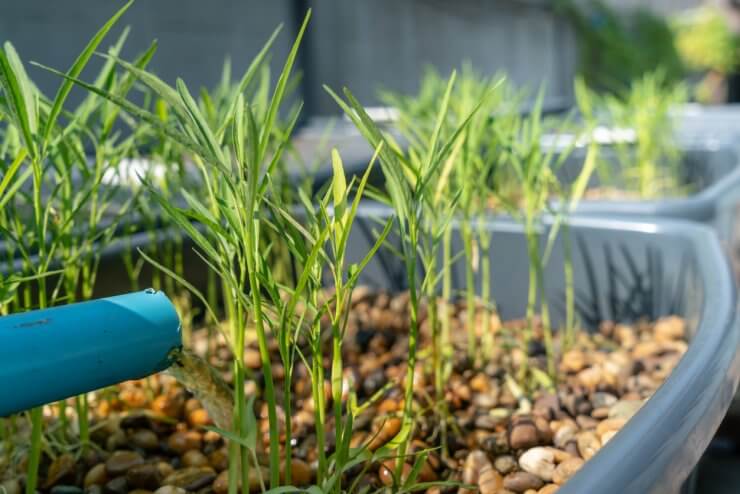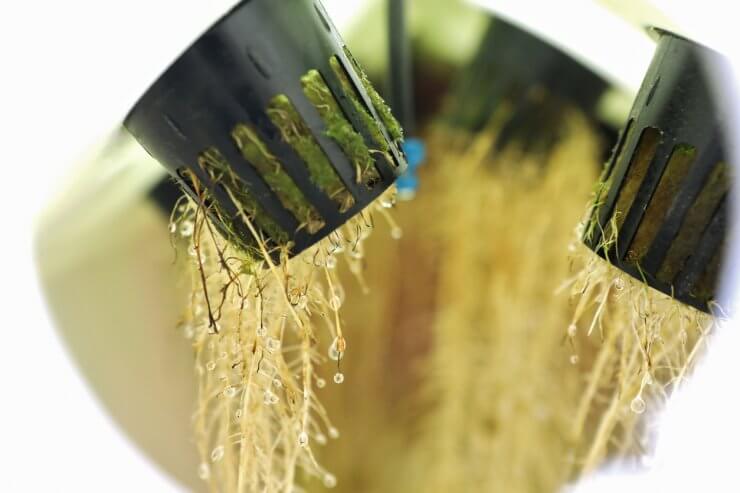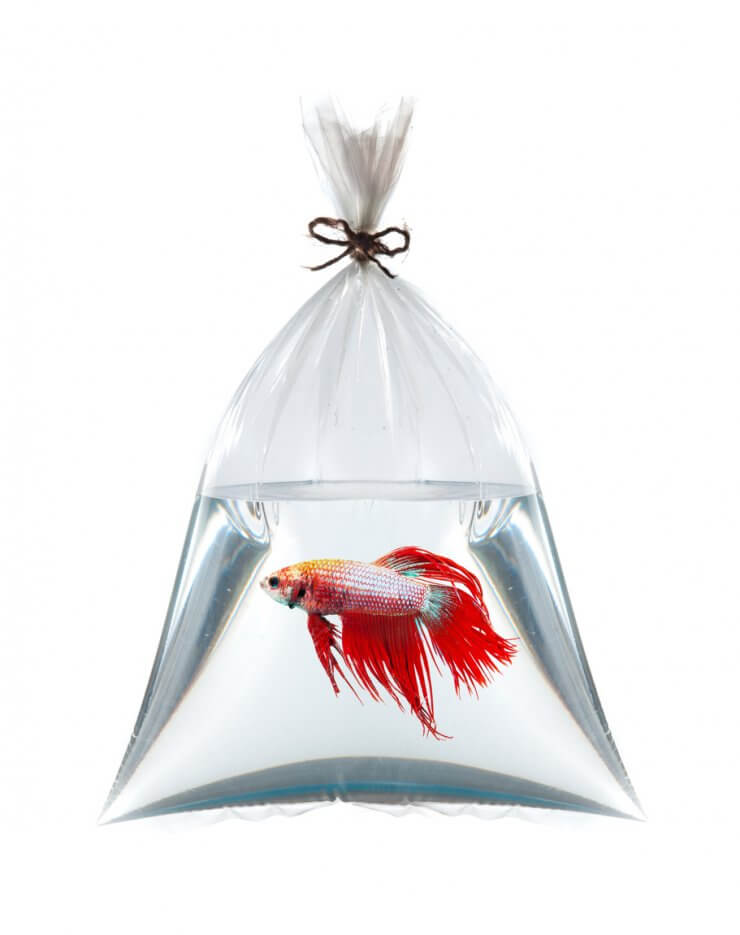
Imagine a stranger came up to you holding a bag of fish from the pet store and said, “Hey, you! Did you know you can grow a garden using live fish?” It’d be a little unsettling. But now imagine it’s me, your trusted gardening friend Amanda grinning at you while holding a bag of betta fish saying the same thing. I’m not selling this, am I? But it’s true! You can grow an aquaponic herb garden using live fish! But before explaining how to create an aquaponic herb garden, I feel like we should back up a bit and talk about what the heck aquaponic gardening is in the first place. You know, to renew your trust in me.
Find out how easy growing spices and herbs can be—indoors or out! Read our FREEBIE How to Master Spice and Herb Gardening at Home right now!
What is aquaponic gardening?
Aquaponic sounds similar to hydroponic because they share the same suffix “-ponic” which literally means “to labor with ” or “to work on.” With hydroponic gardening, water is the prime element working to grow plants. With aquaponic gardening, fish (swimming and pooping in water) work to grow plants. An aquaponic system mimics a natural ecosystem, forming a mutually beneficial relationship among fish, plants, water, and the bacteria and nutrients shared between them. Waste by-products from the fish (fish poop) become food for bacteria, which serve as fertilizer for plant roots. Plant roots absorb that bacteria which cleans the water for the fish.
How to create an aquaponic herb garden using any fish tank
Aquaponic systems can be created in large aquariums and yield big garden beds. But for smaller spaces and home use, an aquaponic herb garden can be made in as small as a large mason jar (64oz+) could even work, though not recommended. However, if you do have a smaller tank (3-5 gallon) betta fish are preferred since they are not a schooling fish, meaning they like being on their own. They also prefer smaller spaces, so they don’t mind living in a smaller tank.

Here are the basic materials you’ll need:
- 3-5 gallon fish tank (or larger)
- Betta fish: The best type of fish for a smaller set up
- Herb plant: Wheatgrass can grow just being sprinkled with clay pebbles (sold in aquaponics stores). Or, for other herbs, they could be started in rockwool. Basil and coriander are excellent choices because they are leafy.
- Topper: You will need to cut or drill a hole in a top that will sit on top of the tank. From there, you’ll add a net pot (below).
- Net pot: This is what it sounds like, a small cup with holes in it, available at your hydroponics store and online.
- Growth medium: This is what your herbs will grow in. Clay pebbles, lava rock, and expanded shale make excellent choices for an aquaponic herb garden.
- Water: A test kit will be helpful too, to make sure it’s ideal for your fish.
Optional add-ons:
- Airstone and/or air pump – these add-ons help circulate and disperse oxygen. If you choose not to use these, you’ll need to change the water every couple of weeks.
- Decorative fish gravel – if you decide to use it, don’t use more than an inch or so, otherwise, it’ll take up too much space.

Instructions:
- Clean and rinse out the fish tank.
- Add clean, decorative gravel and airstone/pump to the bottom of the jar, if desired.
- Fill the tank with water. If you use tap water, use tap water conditioner for fish.
- Acclimate your betta fish to the jar. This may feel like a lengthy step, but it’s the best way to successfully acclimate a new fish to your aquaponic herb garden without having a “burial at sea” fishy funeral. Start by putting the unopened fish bag into the tank and let it float there for 20 minutes. (Note: this may displace a bit of water so you may need to top off later.) Then open the top of your fish bag and scoop some jar water into the fish bag. Add about as much water as there was in the bag so that the volume in the fish bag has doubled. Wait another 20 minutes. Now the tricky part, using a net or scoop, remove the betta fish from the bag and place it in the jar. It’s important not to mix the water in the fish bag with the jar. The reason behind this is that there is a higher risk of disease from the pet store water which can not only affect your fish but also the aquaponic herb garden. Top off the jar with distilled or purified water leaving an inch at the top.
- Wait a few days to a week before adding your herbs. This allows fish waste like nitrogen to build up so that your plant will get optimal nutrition right away.
- Add your cover to your tank, and lower your net pot into the hole you’ve created, with roots touching the water, or add your growing medium topped with seeds.
Once your aquaponic system is up and running there’s little you need to do, other than naming your fish something adorable and talking to them while making your morning coffee. The herb and fish will provide nutrients for each other. If you don’t set up a simple AirStone or air pump with tubing, you will need to change the water every couple of weeks. Harvest your herb leaves as needed, taking care not to deplete the plant fully. And be sure to tell Squiggly I say hello!
Have you ever made an aquaponic herb garden? What are some of your tips and tricks? Let me know in the comments!
Find out how easy growing spices and herbs can be—indoors or out! Read our FREEBIE How to Master Spice and Herb Gardening at Home right now!





Research will prove that a small container is preferred by a Beta fish and is not a cruel and they do not require heat or an air pump,
problem.bettas are caranviors,they need protein,as in betta food either pellets. or flakes.the fish of any sort shouldn’t not be placed in direct sun especially a small container of water will overheat and cook said fish[bettas live naturally murky water.]as well as encouraging algae.A herberous type small
cold water fish and a low heat grow light might work.
Thats relatively cruel towards the fish unless you have a 10 gallon mason jar…. please don’t treat your betta like this.
More than relatively cruel. A mason jar is no where near large enough to home a fish. There’s no mention of a filter or heater. No mention of a bacteria cycle. This is a moronic project done by those who have no empathy for living creatures, directed by some dolt who doesn’t know how to keep something as simplistic as a fish alive.
For anyone who wants to do this, properly, do similar steps in an already running aquarium. The steps given on this page will kill your fish, because once you get a fish, it’s not a plant growing prop. It’s your fish.
OP should be thoroughly ashamed of themselves.
This is an awesome idea! I was just wondering do you feed the fish or does he get food from the roots of the herb?
Are there foto’s anywhere of this in action? I would like to see what a finished jar would look like. Also, where would I find a net pot? Also, again— I would like to put my jar in my kitchen window that gets sun almost all afternoon. Wouldn’t the heat from the sun cook the fish?
I wouldn’t put the fish in the window for that reason, and it will also cause algae to grow. I would choose things that don’t need a lot of sunlight to grow, like lettuce! You can find net pots on Amazon, they look like little black strainers. I’m currently mid-experiment with this, and will update this post with photos! In the meantime, if you search for “mason jar aquaponics” in Google image search you’ll see some photos!